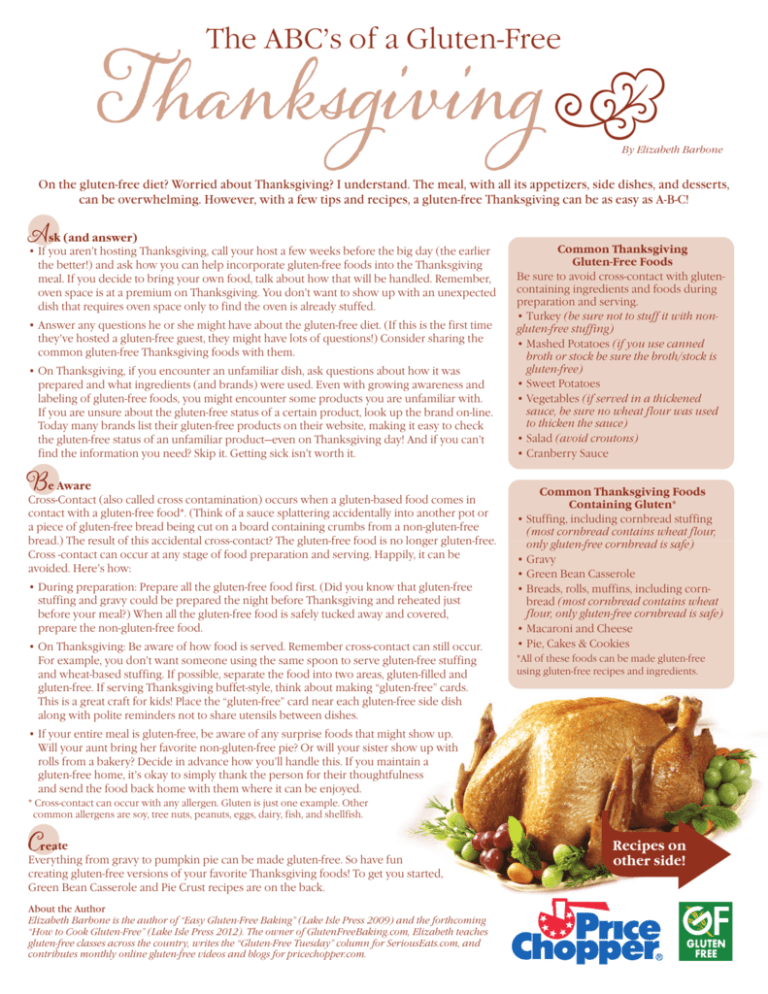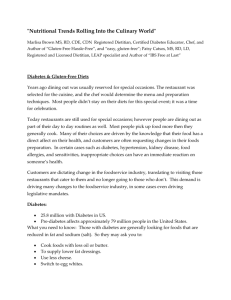The ABC's of a Gluten-Free
advertisement

Thanksgiving v The ABC’s of a Gluten-Free By Elizabeth Barbone On the gluten-free diet? Worried about Thanksgiving? I understand. The meal, with all its appetizers, side dishes, and desserts, can be overwhelming. However, with a few tips and recipes, a gluten-free Thanksgiving can be as easy as A-B-C! A sk (and answer) • If you aren’t hosting Thanksgiving, call your host a few weeks before the big day (the earlier the better!) and ask how you can help incorporate gluten-free foods into the Thanksgiving meal. If you decide to bring your own food, talk about how that will be handled. Remember, oven space is at a premium on Thanksgiving. You don’t want to show up with an unexpected dish that requires oven space only to find the oven is already stuffed. • Answer any questions he or she might have about the gluten-free diet. (If this is the first time they’ve hosted a gluten-free guest, they might have lots of questions!) Consider sharing the common gluten-free Thanksgiving foods with them. • On Thanksgiving, if you encounter an unfamiliar dish, ask questions about how it was prepared and what ingredients (and brands) were used. Even with growing awareness and labeling of gluten-free foods, you might encounter some products you are unfamiliar with. If you are unsure about the gluten-free status of a certain product, look up the brand on-line. Today many brands list their gluten-free products on their website, making it easy to check the gluten-free status of an unfamiliar product—even on Thanksgiving day! And if you can’t find the information you need? Skip it. Getting sick isn’t worth it. B e Aware Cross-Contact (also called cross contamination) occurs when a gluten-based food comes in contact with a gluten-free food*. (Think of a sauce splattering accidentally into another pot or a piece of gluten-free bread being cut on a board containing crumbs from a non-gluten-free bread.) The result of this accidental cross-contact? The gluten-free food is no longer gluten-free. Cross -contact can occur at any stage of food preparation and serving. Happily, it can be avoided. Here’s how: • During preparation: Prepare all the gluten-free food first. (Did you know that gluten-free stuffing and gravy could be prepared the night before Thanksgiving and reheated just before your meal?) When all the gluten-free food is safely tucked away and covered, prepare the non-gluten-free food. • On Thanksgiving: Be aware of how food is served. Remember cross-contact can still occur. For example, you don’t want someone using the same spoon to serve gluten-free stuffing and wheat-based stuffing. If possible, separate the food into two areas, gluten-filled and gluten-free. If serving Thanksgiving buffet-style, think about making “gluten-free” cards. This is a great craft for kids! Place the “gluten-free” card near each gluten-free side dish along with polite reminders not to share utensils between dishes. Common Thanksgiving Gluten-Free Foods Be sure to avoid cross-contact with glutencontaining ingredients and foods during preparation and serving. • Turkey (be sure not to stuff it with nongluten-free stuffing) • Mashed Potatoes (if you use canned broth or stock be sure the broth/stock is gluten-free) • Sweet Potatoes • Vegetables (if served in a thickened sauce, be sure no wheat flour was used to thicken the sauce) • Salad (avoid croutons) • Cranberry Sauce Common Thanksgiving Foods Containing Gluten* • Stuffing, including cornbread stuffing (most cornbread contains wheat flour, only gluten-free cornbread is safe) • Gravy • Green Bean Casserole • Breads, rolls, muffins, including cornbread (most cornbread contains wheat flour, only gluten-free cornbread is safe) • Macaroni and Cheese • Pie, Cakes & Cookies *All of these foods can be made gluten-free using gluten-free recipes and ingredients. • If your entire meal is gluten-free, be aware of any surprise foods that might show up. Will your aunt bring her favorite non-gluten-free pie? Or will your sister show up with rolls from a bakery? Decide in advance how you’ll handle this. If you maintain a gluten-free home, it’s okay to simply thank the person for their thoughtfulness and send the food back home with them where it can be enjoyed. * Cross-contact can occur with any allergen. Gluten is just one example. Other common allergens are soy, tree nuts, peanuts, eggs, dairy, fish, and shellfish. Create Everything from gravy to pumpkin pie can be made gluten-free. So have fun creating gluten-free versions of your favorite Thanksgiving foods! To get you started, Green Bean Casserole and Pie Crust recipes are on the back. About the Author Elizabeth Barbone is the author of “Easy Gluten-Free Baking” (Lake Isle Press 2009) and the forthcoming “How to Cook Gluten-Free” (Lake Isle Press 2012). The owner of GlutenFreeBaking.com, Elizabeth teaches gluten-free classes across the country, writes the “Gluten-Free Tuesday” column for SeriousEats.com, and contributes monthly online gluten-free videos and blogs for pricechopper.com. ➥ Recipes on other side! Recipes v Gluten-Free By Elizabeth Barbone Gluten-Free Green Bean Casserole Serves 6-8 Here’s the classic green bean casserole made gluten-free. You can prepare it through step nine the night before Thanksgiving. On Thanksgiving, follow remaining steps. (Reheating might take longer than twenty minutes, use your judgment.) 1 small onion, minced 8 ounces white button mushrooms, finely chopped (approximately 1 cup) 3 Tablespoons olive oil, divided 2 cups plus 1/4 cup milk, divided Pinch granulated garlic Pinch dried thyme 2 tablespoons cornstarch 1 (16-ounce) bag frozen French-cut green beans 1/4 cup grated Parmesan cheese 1 recipe fried onions, recipe below 1. Preheat oven to 350ºF. (if you will be baking this dish while the turkey is in the oven, whatever temperature you are cooking the turkey will be fine). 2. Heat 2 Tablespoons of olive oil over medium heat in a medium saucepan. 3. Add onion and sauté onion until translucent, stirring occasionally. 4. Add mushrooms and remaining tablespoon of olive oil. Cook until mushrooms are soft and tender. 5. Add two cups of milk, garlic and thyme. Bring to a boil. Once the mixture boils, reduce heat and simmer for 5 minutes. 6. Combine remaining 1/4 cup of milk and 2 Tablespoons cornstarch. Stir vigorously with a fork to combine milk and cornstarch. 7. Return milk mixture to a boil. Quickly whisk in cornstarch mixture. Allow the mixture to boil for 45 seconds. Remove from heat. Set aside. 8. Thaw and drain green beans. Stir into mushroom mixture. 9. Pour green bean mixture into a 1 1/2-quart casserole dish. Top with grated Parmesan cheese. 10. Bake covered for 20 minutes. 11. Remove cover and sprinkle fried onions over the top of the mixture. 12. Return casserole to oven for 5 minutes or until bubbling and lightly golden brown. Fried Onions These fried onions have a high munch factor. Luckily, this recipe easily doubles, or triples, ensuring you have enough for snacking and covering your casserole. 1 medium onion, sliced into thin strips 2 Tablespoons cornstarch 2 Tablespoons white rice flour Vegetable oil Salt, to taste (optional) 1. Combine cornstarch and white rice flour. 2. In a large zip-lock bag, toss onion in flour mixture. Coat well. Remove onions from bag; shake off any excess flour. 3. Fill medium-size frying pan with 1/2 inch of vegetable oil. 4. Heat oil over medium heat until hot (to test your oil, drop one onion slice into it. The onion should sizzle when it hits the oil. If it doesn't, the oil is not hot enough). 5. Fry onions until golden brown and crispy. Turn frequently to ensure even browning. 6. Remove onions from oil using a slotted spoon. Place on paper towels to drain. 7. If desired, season with salt to taste. Use as directed above. Q Gluten-Free Pie Crust This recipe makes enough dough for one single crust 9-inch pie. Double the recipe for “double crust” pies, such as apple. 1 cup white rice flour 1/3 cup potato starch 1/3 cup tapioca starch 1 tablespoon granulated sugar 1/2 teaspoon salt Wet Ingredients 8 tablespoons cold butter, cut into small pieces 1 large egg, beaten 3 tablespoons ice water 1. In a food processor or large bowl, combine dry ingredients. If using a food processor, pulse to combine. Whisk to combine if preparing the pie crust by hand. 2. Add the butter. Pulse to combine or use a pastry cutter to incorporate the butter into the flour mixture. No large piece of butter should remain. Add the beaten egg and water. Pulse until a dough comes together or, using a wooden spoon, stir the water into the dough. 3. Lightly flour a piece of parchment paper with white rice flour. Center the dough on the paper. Lightly flour the top of the dough. Roll out dough into a large circle, about 11-inches. Invert the pie plate over the dough. Slide your hand between the counter and the parchment paper. In one quick motion, flip the dough and pan over. Carefully pull the paper off the dough. If any of the dough rips apart, press it back together. Trim edges, crimp if desired. 4. Use pie dough as directed in your favorite pie recipe. For more gluten-free recipes, please visit pricechopper.com and GlutenFreeBaking.com.



